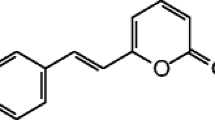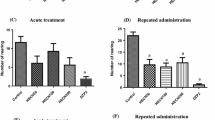Abstract
In mice, apomorphine (10 mg/kg s.c.) does not induce a compulsion to gnaw, but pretreatment with antihistamines, viz. pheniramine, chlorpheniramine and mepyramine, in doses ranging from 30 to 60 mg/kg i.p. caused gnawing activity. Mepyramine showed significantly less effect when compared to the other two agents. Antihistamines are known to influence the activity of biogenic amines in central nervous system. The potentiation of apomorphine-induced gnawing by antihistamines might depend upon the reciprocal balance between dopaminergic and cholinergic systems. This was tested by blocking biosynthesis of biogenic amines or by blocking their receptors. The potentiation of gnawing was antagonised by physostigmine (0.25 mg/kg) or blocked by pretreatment with α-methyl-p-tyrosine (α-MPT) (4×5 mg/kg) and bis-(4-methyl-1-homopiperazinyl-thiocarbonyl)-disulphide (FLA) (40 mg/kg), while p-chlorophenyl alanine (p-CPA) (3×100 mg/kg) had no effect. Similarly, phenoxybenzamine (30 mg/kg) and haloperidol (1.0 mg/kg) inhibited gnawing activity, but methysergide (10 mg/kg) had no effect. Furthermore, pretreatment with tetrabenazine (20 mg/kg) and l-Dopa (200 mg/kg) did not affect gnawing activity. It is concluded that both pheniramine and chlorpheniramine potentiate apomorphine gnawing by upsetting the cholinergic and dopaminergic balance in favour of dopaminergic dominance.
Similar content being viewed by others
References
Andén, N. E., Corrodi, H., Fuxe K., Hökfelt, B., Hökfelt, T., Rydin, C., Svensson, T.: Evidence for a central noradrenaline receptor stimulation by clonidine. Life Sci. 9, 513–523 (1970)
Andén, N. E., Rubenson, A., Fuxe, K., Hökfelt, T.: Evidence for dopamine receptor stimulation by apomorphine. J. Pharm. Pharmacol. 19, 627–629 (1967)
Bartholini, G., Pletscher, A.: Cerebral accumulation and metabolism of C14 dopa after selective inhibition of peripheral decarboxylase. J. Pharmacol. exp. Ther. 161, 14–20 (1968)
Consolo, S., Ladinsky, H., Peri, G., Garattini, S.: Effect of central stimulants and depressants on mouse brain acetylcholine and choline levels. Europ. J. Pharmacol. 18, 251–255 (1972)
Costall, B., Naylor, R. J.: Possible involvement of noradrenaline area of the amygdala with stereotyped behaviour. Life Sci. 11, 1135–1146 (1972)
Costall, B., Naylor, R. J., Wright, T.: The use of amphetamine induced stereotyped behaviour as a model for experimental evaluation of antiparkinson agents. Arzneimittel-Forsch. 22, 1178–1183 (1972)
Ernst, A. M.: Mode of action of apomorphine and dexamphetamine on gnawing compulsion in rats. Psychopharmacologia (Berl.) 10, 316–323 (1967)
Ernst, A. M., Smelik, P. G.: Site of action of dopamine and apomorphine on compulsive gnawing behaviour in rats. Experientia (Basel) 22, 837–838 (1966)
Fuxe, K., Goldstein, M., Ljungdahl, A.: Antiparkinsonian drugs and central dopamine neurons. Life Sci. 9, 811–824 (1970)
Grabowska, M., Antkiewicz, L., Maj, J., Michaluk, J.: Apomorphine and central serotonine neurons. Pol. J. Pharmacol. Pharmac. 25, 29–39 (1973)
Isaac, L., Goth, A.: The mechanism of potentiation of norepinephrine by antihistaminics. J. Pharmacol. exp. Ther. 156, 463–468 (1967)
Koe, B. K., Weissman, A.: p-Chlorophenylalanine: a specific depletor of brain serotonin. J. Pharmacol. exp. Ther. 154, 499–516 (1966)
Kuruma, J., Bartholini, G., Pletscher, A.: l-Dopa induced accumulation of 3-o-methyl dopa in brain and heart. Europ. J. Pharmacol. 10, 189–192 (1970)
Ladinsky, H., Consolo, S., Peri, G.: Effect of oxytremorine and physostigmine on choline levels in mouse whole brain, spleen and cerebellum. Biochem. Pharmacol. 23, 1187–1193 (1974)
Molander, L., Randrup, A.: Investigation of the mechanism by which l-Dopa induces gnawing in mice. Acta pharmacol. (Kbh.) 34, 312–324 (1974)
Nybäck, H., Schubert, J., Sedvall, G.: Effect of apomorphine and pimozide on synthesis and turnover of labelled catecholamines in mouse brain. J. Pharm. Pharmacol. 22, 622–624 (1970)
Pedersen, V.: Potentiation of apomorphine effect (compulsive gnawing behaviour) in mice. Acta pharmacol. (Kbh.) 25, Suppl., 4–23 (1967)
Pedersen, V.: Role of catecholamine in compulsive gnawing behaviour in mice. Brit. J. Pharmacol 34, 219P-220P (1968)
Persson, T., Waldeck, B.: Further studies on the possible interaction between dopamine and noradrenaline containing neurons in the brain. Europ. J. Pharmacol. 11, 315–320 (1970)
Pletscher, A., Borssi, A., Gey, K. F.: Benzoquinolizine derivatives. A new class of monoamine decreasing drugs with psychotropic action. Int. Rev. Neurobiol. 6, 275–306 (1962)
Scheel-Krüger, J.: Central effect of anticholinergic drugs measured by the apomorphine gnawing test in mice Acta pharmacol. (Kbh.) 28, 1–16 (1970)
Sinclair, J. G.: Antihistamine-monoamine oxidase inhibitor interaction in rabbits. J. Pharm. Pharmacol. 24, 955–961 (1972)
Spector, S., Sjoerdsma, A., Udenfriend, S.: Blockade of endogenous norepinephrine synthesis by α-methyl tyrosine, an inhibitor of tyrosine hydroxylase. J. Pharmacol. exp. Ther. 147, 86–95 (1965)
Svensson, T. H.: Increased dopamine concentration in the striatum in the mouse by FLA-63, a dopamine β-oxidase inhibitor. J. Pharm. Pharmacol. 25, 73–75 (1973)
Ther, L., Schramm, H.: Apomorphin-Synergismus (Zwangsnagen bei Mäusen) als Test zur Differenzierung psychotroper Substanzen Arch int. Pharmacodyn. 138, 302–310 (1962)
Walsh, J. A.: Antagonism by methysergide of vascular effects of 5-hydroxytryptamine in man. Brit. J. Pharmacol. 30, 518–530 (1967)
Author information
Authors and Affiliations
Rights and permissions
About this article
Cite this article
Dadkar, N.K., Dohadwalla, A.N. & Bhattacharya, B.K. Influence of pheniramine and chlorpheniramine on apomorphine induced compulsive gnawing in mice. Psychopharmacology 48, 7–10 (1976). https://doi.org/10.1007/BF00423299
Received:
Issue Date:
DOI: https://doi.org/10.1007/BF00423299




